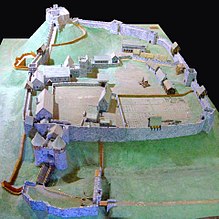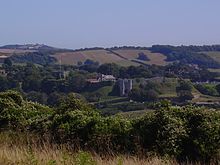Carisbrooke Castle
| Carisbrooke Castle | |
|---|---|
| Carisbrooke, Isle of Wight, England | |
 The interior of Carisbrooke Castle | |
| Coordinates | 50°41′15″N 1°18′48″W / 50.6874°N 1.3133°W |
| Grid reference | grid reference SZ486877 |
| Type | Castle |
| Site information | |
| Owner | Managed by English Heritage |
| Open to the public | Yes |
| Condition | Complete |
| Site history | |
| Built | Begun in 12th century |
| In use | Until 1944 |
| Garrison information | |
| Past commanders | Sir Nicholas Wadham (died 1542) Captain of the Isle of Wight, 1509–1520 |
| Occupants | Isabella de Fortibus, Charles I of England (imprisoned), Princess Beatrice of the United Kingdom |
Carisbrooke Castle is a historic motte-and-bailey castle located in the village of Carisbrooke (near Newport), Isle of Wight, England. Charles I was imprisoned at the castle in the months prior to his trial.[1]
Early history
The site of Carisbrooke Castle may have been occupied in pre-Roman times. A ruined wall suggests that there was a building there in late Roman times. The Anglo-Saxon Chronicle mentions that Wihtgar, cousin of King Cynric of Wessex, died in AD 544, and was buried there. The Jutes may have taken over the fort by the late 7th century. An Anglo-Saxon stronghold occupied the site during the 8th century. Around 1000, a wall was built around the hill as a defence against Viking raids.
Later history

From 1100 the castle remained in the possession of Richard de Redvers' family, and over the next two centuries his descendants improved the castle with stone walls, towers and a keep. In 1293, Countess Isabella de Fortibus, the last Redvers resident, sold the castle to Edward I. From then on, its governance was entrusted to wardens as representatives of the crown.[2]
In 1377, in the reign of Richard II the castle was unsuccessfully attacked by the French. It was reputedly saved by local hero Peter de Heyno who shot the French commander. Anthony Woodville, Lord Scales, later Earl Rivers, obtained a grant of the castle and rights of Lordship in 1467. He was responsible for the addition of the Woodville Gate, now known as the Entrance Gate.[3] Woodville was killed by Richard III in 1483, but his brother Edward Woodville was given control of the castle on the accession of Henry VII in 1485.[4]
The keep was added to the castle in the reign of Henry I, and in the reign of Elizabeth I, when the Spanish Armada was expected, it was surrounded by additional fortifications by Sir George Carey, who had been appointed Governor of the Isle of Wight in 1583. Carey later commissioned the Italian engineer Federigo Giambelli (or Genebelli) to make more substantial improvements to the defences. Starting in 1597, Giambelli constructed a modern trace Italienne fortification, a squat rampart and ditch supported at intervals by powerful bastions, which completely surrounded the old castle and bailey. The new fortification was mostly completed by 1600 at the cost of £4,000.[5]

Charles I was imprisoned here for fourteen months before his execution in 1649.[1] Afterwards his two youngest children were confined in the castle, and Princess Elizabeth died there. From 1896 to 1944, it was the home of Princess Beatrice, daughter of Queen Victoria, as Governor of the Isle of Wight.[6] It is now under the control of English Heritage.[7]
The castle is located above, and to the south of, Carisbrooke village centre.
In 2007, English Heritage opened a holiday flat inside the castle, in converted former staff quarters.[8] The castle received 125,664 visitors during 2018.[9]
Description



Carisbrooke was the strongest castle on the Island; though it is visible from some distance, it does not dominate the countryside like many other castles.
There are traces of a Roman fort underneath the later buildings. Seventy-one steps lead up to the keep; the reward is a fine view. In the centre of the castle enclosure are the domestic buildings; these are mostly of the 13th century, with upper parts of the 16th century. Some are in ruins, but the main rooms were used as the official residence of the Governor of the Isle of Wight until the 1940s, and they remain in good repair.
The Great Hall, Great Chamber and several smaller rooms are open to the public, and an upper room houses the Isle of Wight Museum. Most rooms are partly furnished.
One of the main subjects of the museum is King Charles I. He tried to escape from the castle in 1648, but was unable to get through the bars of his window.
The name of the castle is echoed in a very different structure on the other side of the world. A visit to the castle by James Macandrew, one of the founders of the New Zealand city of Dunedin, led to him naming his estate "Carisbrook". The name of the estate was later used for Dunedin's main sporting venue.
The Main Gate
The gateway tower was erected by Lord Scales who was lord of the castle at the time in 1464.[3]
The Chapel
The chapel is located next to the main gate. In 1904 the chapel of St Nicholas in the castle was reopened and re-consecrated, having been rebuilt as a national memorial of Charles I. Within the walls is a well 200 feet deep and another in the centre of the keep is reputed to have been still deeper.
The Well-House

Near the domestic buildings is the well-house with its working donkey wheel. As it is still operated by donkeys, the wheel is a great attraction and creates long queues. The well is also famous as the hiding place of the Mohune diamond, in the 1898 adventure novel Moonfleet, by J. Meade Falkner.[10] Wyndham Lewis, who lived on the Isle of Wight as a child, cites the donkey wheel at Carisbrooke as an image for the way machines impose a way of life on human beings ('Inferior Religions', published 1917).
The Constable's Chamber
The Constable's Chamber is a large room located in the castle's medieval section. It was the bedroom of Charles I when he was imprisoned in the castle, and Princess Beatrice used it as a dining room. It is now home to Charles I bed as well as Princess Beatrice's large collection of stag and antelope heads. This room was used as the castle's education centre up until recently.
Earthworks
Surrounding the whole castle are large earthworks, designed by the Italian Federigo Gianibelli, and begun in the year before the Spanish Armada. They were finished in the 1590s. The outer gate has the date 1598 and the arms of Elizabeth I.
List of constables of Carisbrooke Castle
| Name | Dates in office | Source |
|---|---|---|
| William Briwere, Jnr | 1217 | [11] |
| Waleran Tyes | 1224 | [11] |
| Savery de Mauleon | 1227 | [11] |
| Bishop of Winchester | 1233 | [11] |
| Benedict | 1269 | [11] |
| Hugh de Hanneby | 1270 | [11] |
| John Hardington | 1277 | [11] |
| Humphrey de Dunster | c.1294 | [12] |
| Sir William Russell | ?–1307 | [13] |
| Nicholas de Bois | 1307/1309? | [14] |
| John de Langford | 1334 | [11] |
| Sir Hugh Tyrrel | 1377 | [11] |
| William de Montagu, Earl of Salisbury | 1382–1397 | [15] |
| Henry Beaufort, 3rd Duke of Somerset | 1457-? | [16] |
| Anthony Woodville | 1467–1483 | [3] |
| Sir Edward Woodville | 1485–1488 | [17] |
| Sir Reginald Bray | 1495–1503 | [11] |
| Sir Nicholas Wadham (d.1542) | 1509–1520 | [18] |
| Thomas Cromwell, 1st Earl of Essex | 1520–1538 | [11] |
See also
References
- ^ a b "English Castles – Carisbrooke Castle". theheritagetrail.co.uk. Archived from the original on 12 September 2009. Retrieved 8 March 2017.
- ^ "CastleXplorer – Carisbrooke Castle". castlexplorer.co.uk. Archived from the original on 30 July 2012. Retrieved 2 January 2009.
- ^ a b c "Fortified Places – Fortresses – Carisbrooke Castle". fortified-places.com. Retrieved 2 January 2009.
- ^ Wilkins, Christopher, The Last Knight Errant: Edward Woodville and the Age of Chivalry, IB Tauris, 2009, p. 133
- ^ Goode, Dominic. "Carisbrooke Castle". fortified-places.com. Retrieved 5 December 2014.
- ^ "Tour UK – A tourist guide to Carisbrooke Castle". touruk.co.uk. Archived from the original on 10 December 2008. Retrieved 2 January 2009.
- ^ "English Heritage – Carisbrooke Castle, Isle of Wight". englishheritage.org.uk. Retrieved 2 January 2009.
- ^ Rix, Juliet (14 July 2007). "Carisbrooke Castle is real thing – and now you can be part of its history". The Independent. Retrieved 13 June 2008.
- ^ "ALVA – Association of Leading Visitor Attractions". alva.org.uk. Retrieved 28 August 2019.
- ^ Falkner, John (2019). Moonfleet. Dilek Atik. pp. 144, 159. ISBN 9781099406003.
- ^ a b c d e f g h i j k Victoria County History, Hampshire, 1912, vol.5, Parishes: Carisbrooke, pp. 4556 35
- ^ Worsley, Sir Richard III, History of the Isle of Wight, London, 1781, p. 86; Victoria County History, Hampshire, 1912, vol.5, Parishes: Carisbrooke, pp. 221–235
- ^ Wiffen, Memorials of the House of Russell, pp. 127–131
- ^ Wiffen, Memorials of the House of Russell, pp. 127–131; Victoria County History, Hampshire, 1912, vol. 5, Parishes: Carisbrooke, pp. 221–235
- ^ The dates appear in error, as quoted by Victoria County History, Hampshire, 1912, vol.5, Parishes: Carisbrooke, pp. 221–235
- ^ Lee, Sidney, ed. (1901). . Dictionary of National Biography (1st supplement). London: Smith, Elder & Co.
- ^ Wilkins, Christopher, The Last Knight Errant: Edward Woodville and the Age of Chivalry, IB Tauris, 2009, pp. 162–3
- ^ History of Parliament
External links
- Carisbrooke Castle official English Heritage information
- Carisbrooke Castle Museum official site
- 'Carisbrooke Castle: island fortress and royal prison' on Google Arts & Culture
- Carisbrooke Church from Blacks Guide to the Isle of Wight, 1870
- Benjamin Franklin's description of Carisbrooke from Journal of a Voyage, 1726
- This article incorporates text from a publication now in the public domain: Chisholm, Hugh, ed. (1911). "Carisbrooke". Encyclopædia Britannica (11th ed.). Cambridge University Press.

